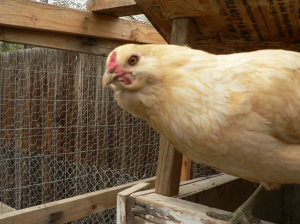
Sesame looking at me from her vantage point on the rim of her open coop.
It’s June and this is when I got my batch of peeps in the mail last year. They’re one year old! (ok, next week). It’s gotten me to thinking that there are probably a lot of folks out there looking to build their first hen shelter, and I thought I would share what we did for ours, because it was cheap, easy and is working out really darned well for our girls; they seem to be warm, safe and pretty happy. Before you shell out big bucks for a custom coop, check out this list of basic needs that you need to cover, and see if it’s not something you can scrounge up some materials for and do yourself!
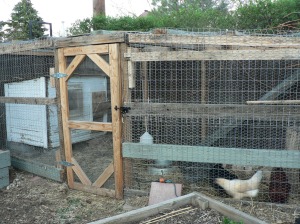
Our 6-bird coop (currently inhabited by 4).
First of all, we live in the 21st century and there is no way that we will be here every morning to let the chickens out, and every evening (right at dusk!) to lock them up. We have jobs, and sometimes we even go out of town for a long weekend. So our first consideration was simply to enclose their actual coop (the little house they sleep in) inside a larger, completely enclosed and secured run. Here, with a small hinged door that can be propped open and stay that way for days at a time, they can come and go from their house morning and night, and still be safe from predators. And we can leave the property for more than 12 hours.
Another detail to point out in the above photo is that you don’t want to be stooped over all the time while you are in the run with your birds (hanging out with them, cleaning, collecting eggs, whatever). So we built it to be higher than my head, even if it does seem like more vertical space than a couple of plump, mostly earthbound birds would need.
Flaws: since we salvaged an old dog house to use as the coop, we couldn’t have a nest box attached to the outside fence with a flap to get eggs through, so we have to actually enter the enclosure and step in chicken poo every single day. But all in all, a small trade-off for not having to build the actual henhouse part of this project.
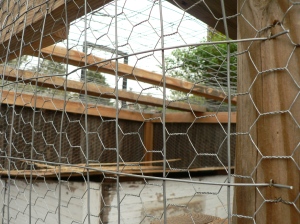
Two kinds of wire used to fence in the chicken run.
Next, I want to point out that we had to use two different types of wire to enclose this run. One is poultry netting a.k.a. chicken wire, which we enthusiastically bought a million yards of, thinking it was all we’d need. Turns out that a raccoon can bend the stuff and create a hole big enough to walk right in, which I was fortunate enough to read about rather than experience. But the larger, stronger wire (hardware wire, with about 2″ x 4″ openings) is of course too large for 8-week old chicks and they themselves will walk right through it. Not to mention any number of other critters. So we ended up with a combination – and I believe I am not the first one to do it this way.
Another important detail: The top of the run is also covered in wire, necessary if you have hawks or owls (and who doesn’t?). Or raccoons, and I hear that foxes climb as well.
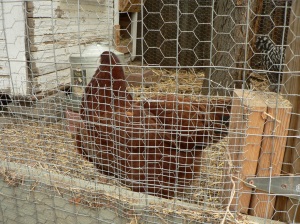
Hardware cloth 'raccoon guard' around the base of the run.
There is one more kind of wire on this run: it’s called hardware cloth (though where the word cloth comes in, I sure don’t know) and it’s really expensive. We paid $30 for a piece just big enough to do the gate. However, because those crafty raccoons will also reach through chicken wire and pull bits of chicken through the fence with potentially gory results (’nuff said?), you need something with really small openings around the bottom of the run. We used some leftover pieces to add some just to chicken height, reasoning that the raccoons would not be able to reach down and grab a bird from any higher than this. It might at least buy the girls enough time to get away from the sides of the coop.
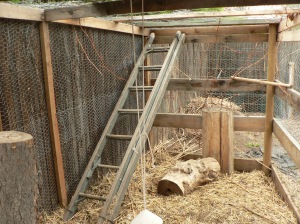
Jungle gym for chickens: lots to climb and perch on.
Because we live around a lot of predators (owls, hawks, eagles, raccoons, foxes, coyotes, possums, snakes and dogs, to name a few) we only let the girls free-range when we’re home and can keep an eye on them, ie. evenings and weekends. The rest of the time they are “cooped up” in this run. So we built in plenty of things for them to do so they could stay in shape and not resort to picking at each other out of boredom. Here you can see stumps and logs, a ladder, and a roost; behind the camera there is also a dust-bathing corner which I resupply periodically with a fresh bag of sand. Plus, their house itself is both short enough to fly on top of and set high enough on concrete blocks for them to crawl underneath for extra entertainment, shade or shelter.
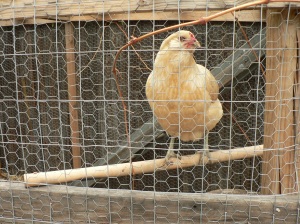
Sesame on the perch inside the run.
Here Sesame, my Ameracauna, is demonstrating the use of their outdoor roost. She is smaller bodied and the most nimble of my girls, and easily hops and flies around to various perches. The twiggy thing in the picture is a grapevine, which is greening up as I write this and will soon provide the girls with tantalizing snack food as well as shade.
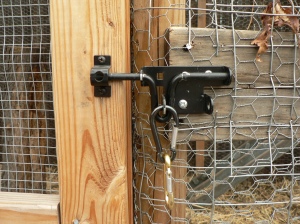
Predator-proof lock? We hope so...
They say – back to those darned raccoons – that if a 4-year-old child can open a lock, a raccoon can figure it out. I have not kid-tested this carabiner system yet, but figure it requires enough dexterity that it’s a good deterrent. The latch won’t slide unless you remove the ‘biners, and they’re pretty tricky. Whatever you do, make sure it’s not just a simple latch! We had a padlock for a while, but soon gave up on it when it started seizing up in the cold and wet and we almost couldn’t get in a few times to let the girls out of their coop or feed them.
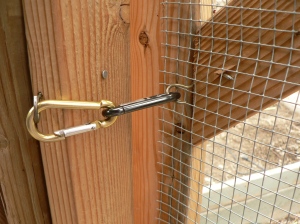
Inside view of gate closing mechanism.
When I go inside to feed the girls or collect eggs, this is what I do with the ‘biners. It keeps the gate shut behind me, because it doesn’t stay shut on its own – which results in runaway chickens and lots of wasted time before work.
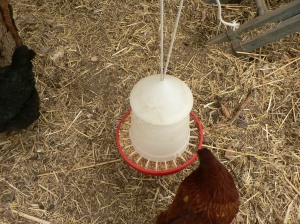
Hanging chicken feeder
You’ve probably seen these over-priced beauties in the feed store, but they really are the best way to feed your birds without feeding the rest of the neighborhood. It helps keep a lot of litter out of the feed, too.

Galvanized steel poultry waterer.
And put your watering thing on top of at least a couple of good level pavers; this will keep a lot of dirt and junk out of their water. In winter, I keep it on top of a heated base which we have to run power to with an extension cord. It beats the heck out of breaking ice every couple of hours.
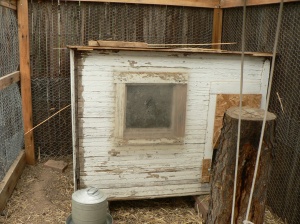
The shoddy-looking but functional coop.
A quick note on coop construction: whatever you do, you need a window (for light) and ventilation. On this reclaimed doghouse, we just removed the roof and replaced it with a new plywood roof that is hinged in the back. I can prop it open it a little or a lot for ventilation on warm nights or during the day (see picture below); the rest of the time it’s quite snug.
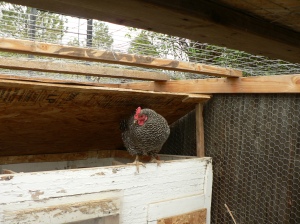
Java sitting on the rim of her ventilated coop.
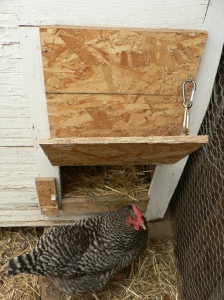
Hinged coop door. A second set of 'biners holds it open during the day.
Java was in the mood to do some modeling, so here are a few more shots of the more functional components of our coop. Since the dog-sized door was letting in way too much cold air, we boarded most of it up and left a small chicken-sized opening with a hinged flap. We can use the carabiners to hang it open during the day or for several days if we’re out of town. The flap provides yet another perch for the girls to play on when it’s open.
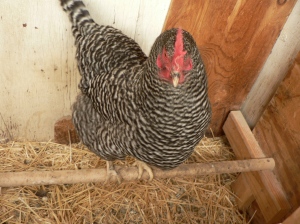
Inside the coop: Java modeling the use of the roost.
Believe it or not, this pint-sized coop has enough space inside for 6 chickens to snuggle up to each other and still have a little space on each side. All chickens want to sleep on a roost, so you must provide one. They settle down with their down feathers covering their bare feet and stay nice and warm (I do provide a lamp on the coldest nights). This roost is only about 6 inches off the floor of the coop, but the important thing is that it’s off the floor so they can hop up to sleep.

4 eggs and a golf ball (left there as a deterrent to egg-pecking).
Finally, a quick view of a nest box. We have two inside the coop, and installed them such that the coop roof, when closed, is the lid on the nest boxes so all I have to do to collect eggs is lift up the roof and reach in from above. Pretty clever if I say so myself. All 4 girls use the same nest box; the other appears to be untouched 99% of the time. But it’s having the choice that matters, I suppose.
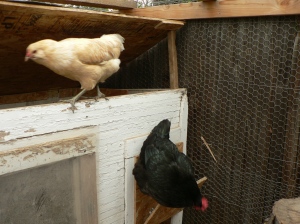
Parting shot: Sesame and Curry using the open chicken coop for recreation.
Despite this long post and the many exhaustive photos, I want to emphasize that chickens have few needs – but they are concrete needs and must be fulfilled. However, as you can see, it’s perfectly easy to meet those needs in a wide variety of ways, using all sorts of salvaged and found materials, and without having to spend a fortune (or a lifetime) on a chicken Taj Majal. My next project is to paint the coop – but I am sure only I will care about the results. The girls are safe, busy, have a sheltered place to sleep and lay their eggs, and I even have a little space to spare… in case I want to expand my little flock. (It’s always a good idea to build for more chickens than you actually want to get).
I hope this helps someone out there come up with their own creative solutions to chicken housing. Good luck with your coops and most especially with your peeps!!




